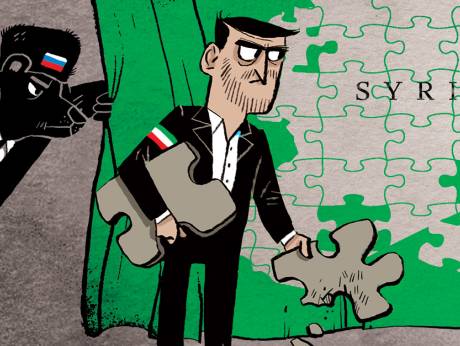When pro-Al Assad alliance begins to crumble
If the price for pushing Iran out of Syria is a conditional rehabilitation of President Bashar Al Assad, the US administration seems to be willing to pay. That is if it leads to a weakening of Iran’s strategy in the Middle East. President Donald Trump has made it clear on several occasions that his aim is to erase Iran’s powerful presence in Syria.
In his maiden speech as Secretary of State in May, following Trump’s decision to withdraw from the Iran nuclear deal, Mike Pompeo promised that his country will confront Iran’s Islamic Revolutionary Guard Corps (IRGC) and its multifaceted militia network, particularly Hezbollah, throughout the region. One of IRGC leading generals, Qassim Sulaimani, has recently prided himself by declaring that he can safely travel, uninterruptedly, from Tehran through to Baghdad, to Damascus and Beirut.
So far, the American threat is limited to strong words and it is not yet known how the new US plan will be implemented. Previous administrations have failed to come up with any clear strategy for curtailing Tehran’s rising influence in Syria which has become the Middle East hottest battlefield since 2011. Former president Barack Obama’s decision during his first term in office to put an end to his country’s military power in Iraq without a plan B, has dangerously created a huge political vacuum that was hurriedly filled by aggressively ambitious Iran.
But recent developments indicate a possible turnaround of events in the hotly contested Syrian war zones because of rethinking process of how best to achieve the aim of containing Iran. This seems to be imminent because of apparent cracks in the Russia-Iran alliance that has been shoring up Al Assad’s regime for the last three years at least.
Russia, on the one hand, is moving forward to deepen its political and military coordination with Israel, which involves direct intelligence exchanges. Israel’s prime minister Benjamin Netanyahu was, last May, a guest of honour at a major military parade in Moscow celebrating Russia’s victory in Second World War. This was his seventh visit to Moscow in less than two years.
Earlier that month, following what it was believed to be an Iranian rocket fired against Israeli positions in occupied Golan Heights, Israel retaliated with unprecedented raids against Iranian targets inside Syria. A total of 50 targets that included every known Iranian base and installation were struck, setting back Iran’s military presence in Syria for years to come. Remarkably, none of Al Assad’s military positions, nor any Russian installation were hit. It is now commonly known that Israel had informed the Russians in advance of their intended air strikes. Moscow, theoretically an ally of Tehran, has its own powerful Hmaimeem airbase in the north coast of Syria with effective radars and surface-to-air missiles, that could hugely hamper the Israeli air attacks if they wanted to. But the Russians have done none of that.
Reducing tensions
Two other players, namely Turkey and the US, have apparently reached what seems to be a workable level of understanding to coordinate their activities in the heavily Kurdish populated parts of Syria, particularly in Manbij area. Recent reports suggest that the US and Turkish forces are jointly running security control in coordination with the four Syrian Democratic Forces (SDF) military councils operating in this area. Turkey has previously considered SDF among its top enemies in North-East Syria. This coordination has significantly reduced the tensions between the two.
But, on the other hand, the rising tensions between the three outside powers, namely Russia, Iran and Israel, with most significant strategic interests in the country, anxiously remain to be settled. Both Russia and Iran have the key military power behind the Al Assad regime. The latter may have been thrown out from his presidential palace, overlooking the capital Damascus, without such backing.
It seems undoubtedly obvious that Moscow’s balancing act between Israel and Iran strategically serves Russian interests above anything else. The Russians have effectively left the skies over Syria and Lebanon open for Israeli air strikes to unfold. It is also reported that Moscow’s position on Israel’s air activities over the two countries remain unchanged till now. It is no longer a secret that a permanently manned Israeli-Russian hot-line is regularly in operation to ensure smooth missions for both in the country.
What does this mean for Russia strategy in Syria? Is it time for Moscow to seriously reconsider its alliance with Tehran? It is undoubtedly clear that the two no longer see eye-to-eye as the war in Syria is currently entering new critical phase. Things have drastically changed after the long bloody war. In his latest press interviews, Al Assad seems more confident than he has ever been since the youth intifada in the southern town of Dara’a in March 2011.
Since then, his regime looked like it was about to crumble at least twice in 2014 and 2016. Since the arrival of Iranian IRGC in 2014 and Russian forces in the country in 2015, Moscow provided air power and Iran established its various network of militias, Hezbollah from Lebanon, Popular Mobilising Forces from Iraq, mercenaries from Afghanistan and Pakistan, who fortified Al Assad’s forces on the ground.
Russia is clearly keen to end the war in Syria and prepare the country to receive international aid and support to put Syria on the safe path to rebuilding. Moscow is aware that such aid won’t be forthcoming unless the heavy presence of Iran in the country is ended or at least widely diminished.
Source: When pro-Al Assad alliance begins to crumble | GulfNews.com

